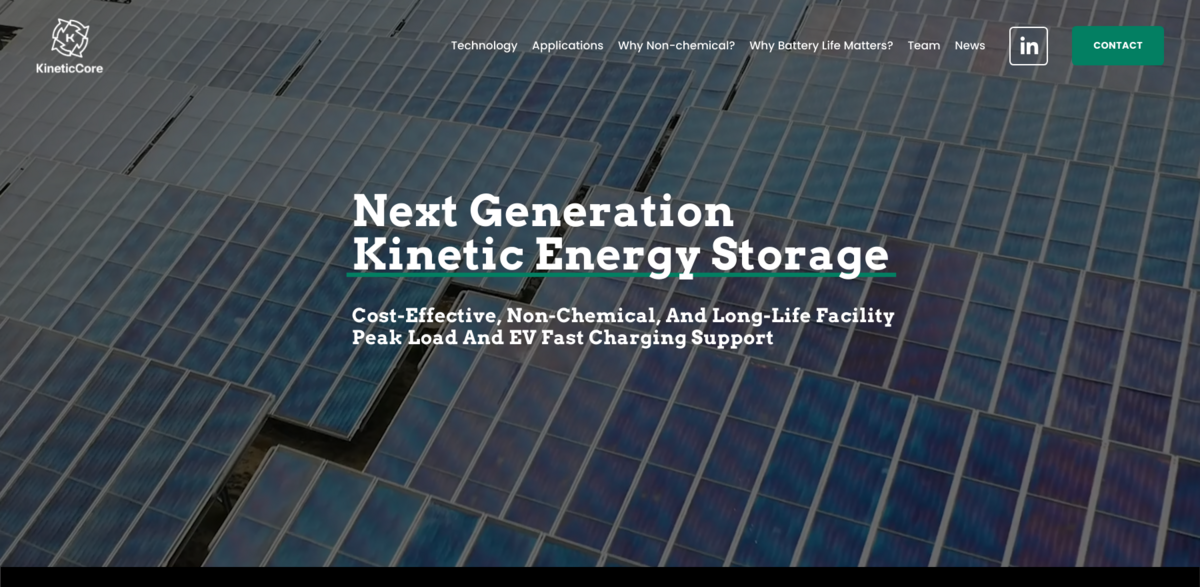What is KineticCore Solutions Flywheel Battery Technology?
KineticCore Solutions has set the stage for a revolutionary shift in energy storage with its innovative flywheel battery technology. Located in Loveland, CO, the project is all about reimagining kinetic energy storage to support the next generation of alternative energy. This isn’t just any battery—it’s a stationary, high-power kinetic battery that offers rapid sub-second reactions, a design built on the strength of carbon and steel, and a commitment to long lifecycle performance. The technology is designed to meet the escalating power demands of commercial, industrial, and EV fast charging applications while ensuring peak load support and grid stability. This kinetic energy storage solution is paving the way for affordable, resilient, and safe energy storage alternatives that make sense in today’s fast-paced energy market…
Key Benefits & Performance Metrics
- Sub-second reaction times delivering 250 kW of peak power.
- Capable of storing energy for durations ranging from 12 minutes to 2 hours.
- Supports up to 48 charge/discharge cycles per day at a high 97% efficiency without extra heating or cooling needs.
- Offers a consistent 25+ year lifespan with no need for replacements.
- Cost advantages include up to 60% lower costs than Li-ion batteries for peak load support and lifecycle costs below $0.03/kWh.
Cost-Effective & Reliable Energy Storage
This solution is built with a keen eye on efficiency and affordability. Its low-weight, small footprint design makes deployment simpler and less disruptive, while its ability to support behind-the-meter peak load shaving—up to an astounding 86% reduction—serves commercial and industrial facilities by lowering electric utility bills and deferring infrastructure upgrades by up to 75%. With minimal lifecycle costs and the promise of long-term reliability unaffected by local temperatures or daily cycle rates, the flywheel battery technology stands out as a strong contender against traditional chemical batteries. This is technology that truly marries performance with economy, ensuring that each installation is as future-proof as it is effective…
Safety & Environmental Advantages
Emphasizing safety and sustainability, the design of the kinetic energy storage system is non-chemical in nature. It is crafted mainly from carbon and steel, which means there is no risk of uncontrolled fires, explosions, or toxic gasses—hazards all too common with regular Li-ion batteries. The absence of hazardous materials removes the burdens of complicated transport, setup, or recycling processes. In a world increasingly sensitive to environmental impacts, this innovation offers a safe, non-hazardous alternative that minimizes risks while enhancing the overall sustainability of energy storage systems. The project contributes to a cleaner planet while ensuring that energy storage remains both practical and secure.
Versatile Applications & Future-Ready Solutions
The versatile nature of this technology allows it to serve an impressive range of applications. From behind-the-meter peak load support in commercial and industrial facilities to EV fast charging solutions that reduce costly infrastructure upgrades, the flywheel battery excels across multiple domains. It also provides essential support for future microgrids and renewable installations by delivering load shifting capabilities, power smoothing, and ramp/rate regulation. Moreover, its DC-coupled design and flexible operations help facilities meet electrification targets, drive down overall energy costs, and even boost revenues by up to 30%. By eliminating common barriers to energy storage, this technology makes a strong case for a future where efficient, adaptable, and affordable energy storage is within reach for all.
Comparative Advantages Over Chemical Batteries
Traditional energy storage systems have long relied on chemical batteries such as Li-ion, which carry hazardous chemicals, require frequent replacement, and come with significant recycling challenges. In contrast, this kinetic battery’s long-life design of more than 25 years creates an opportunity to redirect the energy equivalent of up to 200 kWh from every single battery unit in EV usage. Over the course of its lifetime, a flywheel battery can effectively substitute the capacity of up to 20 Li-ion battery packs, dramatically reducing both the environmental footprint and operating costs. With its non-chemical build, this technology avoids many of the pitfalls associated with rapid degradation, hazardous waste, and high replacement expenses, making it immediately attractive for a sustainable energy future…
Project Impact on Sustainable Development Goals
- SDG 7: Affordable and Clean Energy
- SDG 9: Industry, Innovation and Infrastructure
- SDG 11: Sustainable Cities and Communities
- SDG 12: Responsible Consumption and Production
- SDG 13: Climate Action
Transforming the Energy Storage Landscape
By redefining how energy storage is approached, this flywheel battery technology is transforming traditional market dynamics. Its innovative design, featuring high-energy efficiency, low operational costs, and outstanding safety measures, removes many of the common obstacles faced by current chemical battery systems. Investors, facility operators, and policymakers have an opportunity to embrace a system that not only meets the technical performance needs of modern energy loads but also aligns with environmental sustainability goals. The blend of affordability, sustainability, and robust performance introduces a new chapter in the evolution of energy storage—one that is both dynamic and forward-thinking. This transformation promises to foster a resilient energy infrastructure where renewable sources can seamlessly integrate with state-of-the-art storage solutions, ensuring cleaner and more dependable energy supplies for generations to come…





















